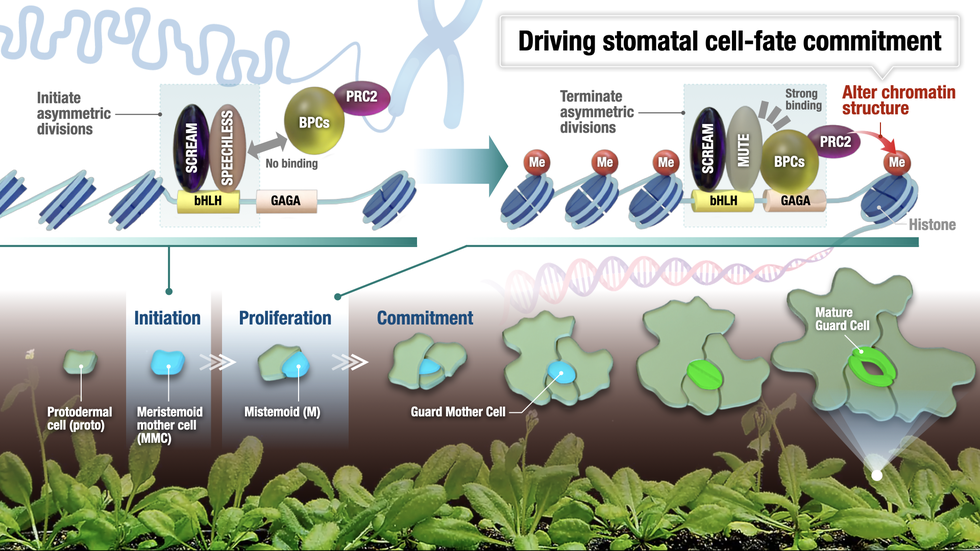
Biology
February 13, 2023
Scientists find unlikely pairs of DNA elements and regulator proteins make small plant stem cells destined to become tiny mouths
Researchers at Nagoya University in Japan, the University of Texas at Austin, and the University of Washington have elucidated a mechanism that makes tiny plant stem cells destined to give rise to stomata, cellular valves of plants that facilitate global carbon cycles.
Like our own cells, such as neurons and muscle fibers, plants give rise to cells with a special functionality. One such cell type is a stoma (plural stomata) -- a pair of guard cells that surround a pore for efficient exchange of carbon dioxide and oxygen. The stomata adjust the release of water vapors to prevent the plants from wilting. During the development of a dicot leaf, including that of a model plant Arabidopsis, stem cells for stomata continue to emerge and each of them eventually becomes a stomatal guard cell.
Scientists know the identity of the master regulatory transcription factors of stomata, a type of protein that binds to DNA and regulates the expression of numerous genes to make stomata. They include SPEECHLESS and MUTE, two 'sister' master regulators that sequentially initiate and terminate the stem cell state of stomata. However, a big mystery remains: How can these master regulators coordinate with the actual genome state of stem cells to switch their fate?
In an article published in Nature Plants on December 15, 2022, researchers reported the genome-wide atlas of genome state (known as chromatin-accessibility) during stomatal development. In a nucleus of eukaryotic cells, genome DNA is bundled with histone proteins, a complex known as a chromatin. Transcription factors can access to the 'open chromatin region', the place where the actions of gene expression are happening.
Using a technique called ATAC-sequencing, genome-wide profiling of accessible chromatins during stomatal development revealed that major reprogramming occurs at the point of stem cell proliferation to differentiation. The researchers also discovered that two DNA codes (called cis-regulatory elements) are highly enriched in the early stomatal lineage: E-box, where transcription factors known as bHLH proteins bind, and GAGA-repeats, where transcription factors called BPCs bind in plants.
What is the significance of these two DNA codes? SPEECHLESS and MUTE, two sequentially-acting master regulators, are bHLH proteins and they bind to these E-boxes. The researchers further discovered that MUTE, but not SPEECHLESS, strongly binds to BPCs, which bind to GAGA-repeats. Other scientists have shown that BPCs recruit enzymes that 'tag' the repressive marks to chromatins. However, the current study revealed that during the differentiation of stem cells, MUTE binds with BPCs, then brings chromatin modifiers to establish repressive chromatin environment, thereby locking-in the genomic state to differentiation.
"We are very surprised and excited,” said Professor Keiko Torii, the senior author. "Our genome-wide survey of chromatin accessibility tells us why it is important that the plants utilized sister master-regulators, SPEECHLESS and MUTE. They have similar but opposite roles-- one initiates and maintains, and the other terminates the stomatal stem cell state. Now we know that only one of them --MUTE-- can bring in BPCs to change the chromatin state. This means that two different classes of transcription factors and two different classes of DNA elements work together to lock in the fate of a plant cell. Our finding expands on how different cell types can be made".
The paper, "Dynamic chromatin accessibility deploys heterotypic cis/trans acting factors driving stomatal cell fate commitment," was published in the journal Nature Plants on December 15, 2023, at DOI: 10.1126/sciadv.abq6161.
Authors:
Eun-Deok Kim, Michael W. Dorrity, Bridget A. Fitzgerald, Hyemin Seo, Krishna Mohan Sepuru, Christine Queitsch, Nobutaka Mitsuda, Soon-Ki Han, and Keiko U. Torii
Institute of Transformative Bio-Molecules (ITbM) website: